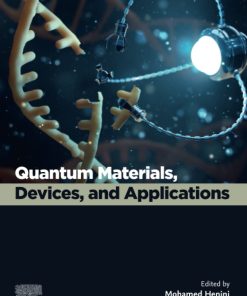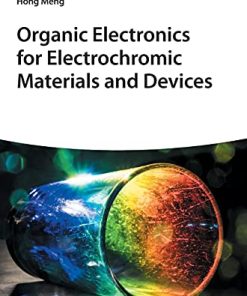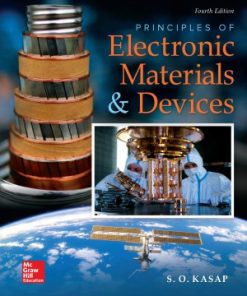(Ebook PDF) Quantum Physics of Semiconductor Materials and Devices 1st edition by Debdeep Jena 0192598929 9780192598929 full chapters
$50.00 Original price was: $50.00.$25.00Current price is: $25.00.
Quantum Physics of Semiconductor Materials and Devices 1st edition by Debdeep Jena – Ebook PDF Instant Download/DeliveryISBN: 0192598929, 9780192598929
Full dowload Quantum Physics of Semiconductor Materials and Devices 1st edition after payment.
![]()
Product details:
ISBN-10 : 0192598929
ISBN-13 : 9780192598929
Author: Debdeep Jena
”Quantum Phenomena do not occur in a Hilbert space. They occur in a laboratory”. – Asher Peres Semiconductor physics is a laboratory to learn and discover the concepts of quantum mechanics and thermodynamics, condensed matter physics, and materials science, and the payoffs are almost immediate in the form of useful semiconductor devices. Debdeep Jena has had the opportunity to work on both sides of the fence – on the fundamental materials science and quantum physics of semiconductors, and in their applications in semiconductor electronic and photonic devices. In Quantum Physics of Semiconductors and Nanostructures, Jena uses this experience to make each topic as tangible and accessible as possible to students at all levels. Consider the simplest physical processes that occur in semiconductors: electron or hole transport in bands and over barriers, collision of electrons with the atoms in the crystal, or when electrons and holes annihilate each other to produce a photon. The correct explanation of these processes require a quantum mechanical treatment. Any shortcuts lead to misconceptions that can take years to dispel, and sometimes become roadblocks towards a deeper understanding and appreciation of the richness of the subject. A typical introductory course on semiconductor physics would then require prerequisites of quantum mechanics, statistical physics and thermodynamics, materials science, and electromagnetism. Rarely would a student have all this background when (s)he takes a course of this nature in most universities. Jena’s work fills in these gaps and gives students the background and deeper understanding of the quantum physics of semiconductors and nanostructures.
Quantum Physics of Semiconductor Materials and Devices 1st Table of contents:
I Fundamentals
And off We Go!
Beyond belief
A brief history of semiconductors
Future
These boots are made for walking
Chapter summary section
Further reading
Exercises
Quantum Mechanics in a Nutshell
Planck’s photon energy quanta
Bohr’s electron energy quanta
Wave-particle duality
The wavefunction
Operators
States of definite momentum and location
States of definite energy: The Schrödinger equation
Time-dependent Schrödinger equation
Stationary states and time evolution
Quantum current
Fermions and bosons
Fermion and boson statistics
The Spin-statistics theorem
The Dirac equation and the birth of particles
Chapter summary section
Further reading
Exercises
Damned Lies and Statistics
Quantum statistics and entropy
The physics of equilibrium
Partition function for quantum systems
The Fermi–Dirac distribution
The Bose–Einstein distribution
Properties of the distribution functions
Quantum twist on thermodynamics
Meaning of equilibrium in semiconductor devices
Chapter summary section
Further reading
Exercises
Electrons in the Quantum World
In Schrödinger equation we trust
The free electron
Not so free: Particle on a ring
The electron steps into a higher dimension: 2D
Electrons in a 3D box
The particle in a box
The Dirac delta potential
The harmonic oscillator
The hydrogen atom
Chapter summary section
Further reading
Exercises
Red or Blue Pill: Befriending the Matrix
The expansion principle
Matrix mechanics
Matrices and algebraic functions
Properties of matrix eigenvlaues
Looking ahead
Chapter summary section
Further reading
Exercises
Secrets of the Classical Electron
Our ancestors knew metals
Discovery of the electron and its aftermath
Drude’s model explains Ohm’s law
Metals are shiny
Metals conduct heat
Icing on the cake: The Wiedemann–Franz law
All is not well
Chapter summary section
Further reading
Exercises
Quantum Mechanics in a Nutshell
Planck’s photon energy quanta
Bohr’s electron energy quanta
Wave-particle duality
The wavefunction
Operators
States of definite momentum and location
States of definite energy: The Schr¨odingerequ tion
Time-dependent Schr¨odinger equation
Stationary states and time evolution
Quantum current
Fermions and bosons
Fermion and boson statistics
The Spin-statistics theorem
The Dirac equation and the birth ofparticles
Chapter summary section
Further reading
Exercises
Damned Lies and Statistics
Quantum statistics and entropy
The physics of equilibrium
Partition function for quantum systems
The Fermi–Dirac distribution
The Bose–Einstein distribution
Properties of the distribution functions
Quantum twist on thermodynamics
Meaning of equilibrium in semiconductordevices
Chapter summary section
Further reading
Exercises
Electrons in the QuantumWorld
In Schr¨odinger equation we trust
The free electron
Not so free: Particle on a ring
The electron steps into a higherdimension: 2D
Electrons in a 3D box
The particle in a box
The Dirac delta potential
The harmonic oscillator
The hydrogen atom
Chapter summary section
Further reading
Exercises
Red or Blue Pill:Befriending the Matrix
The expansion principle
Matrix mechanics
Matrices and algebraic functions
Properties of matrix eigenvlaues
Looking ahead
Chapter summary section
Further reading
Exercises
Perturbations to the Electron’s Freedom
Degenerate perturbation theory
Non-degenerate perturbation theory
The Brillouin–Wigner perturbation results
Rayleigh–Schrödinger perturbation results
The Hellmann–Feynman theorem
Perturbation theory example
Chapter summary section
Further reading
Exercises
II Bands, Doping, and Heterostructures
Electrons in a Crystal Get Their Bands, Gaps, and Masses
The free–electron
Periodic perturbation
Bands, gaps, and effective masses
Non-degenerate perturbation theory
Glimpses of the Bloch theorem
Non-periodic potentials and scattering
Chapter summary section
Further reading
Exercises
Bloch Theorem, Bandstructure, and Quantum Currents
The Bloch theorem
Bloch theorem: aftermath
Real and reciprocal lattice, Brillouin zones
Velocity of Bloch states
Dynamics of Bloch states
Bloch wave velocity and ballistic current
Transport by Bloch waves with scattering
Energy (heat) current
Any current
Quantum Wiedemann–Franz law
Metals, semiconductors, semimetals and insulators
Chapter summary section
Further reading
Exercises
Crystal Clear: Bandstructure of the Empty Lattice
Diffraction as a sharp eye
Bragg diffraction condition
Broken symmetries and physical laws
Bravais lattices
Nearly free–electron bandstructure
Chapter summary section
Further reading
Exercises
Tight-Binding Bandstructure
Atoms, bonds, and molecules
Bandstructure of 1D, 2D, and 3D crystals
1D, 2D: nanotubes, graphene, BN, MX2
3D FCC: Si, GaAs
3D wurtzite: GaN, AlN, ZnO
Tight-binding to design new properties
Chapter summary section
Further reading
Exercises
k p Bandstructure
k p theory
Symmetry
Analytical model without spin
Non-parbolicity and sum rules
The Kane model with spin-orbit interaction
Chapter summary section
Further reading
Exercises
1, 2, 3 … : Pseudopotentials and Exact Bandstructure
The empire strikes back
Exact bandstructure of the Dirac comb potential
Tight-binding models emerge from Kronig–Penney
Point defects in Kronig–Penney models
Green’s functions from Kronig–Penney models
Pseudopotentials: what they are and why they work
Bandstructure of Si, Ge, and GaAs
Bandstructure of AlN, GaN, and InN
Pseudopotentials to DFT and beyond
Chapter summary section
Further reading
Exercises
Doping and Heterostructures: The Effective Mass Method
Effective mass approximation, envelope functions
3D, 2D, 1D, 0D: heterostructures
3D bulk bandstructure
Doped semiconductors
2D quantum wells
1D quantum wires
0D quantum dots
Finite barrier heights
Multilayers and superlattices
Wannier functions
Chapter summary section
Further reading
Exercises
Carrier Statistics and Energy Band Diagrams
Carrier statistics
EF is constant at thermal equilibrium
Metal-semiconductor Schottky junctions
p-n homojunctions
Heterojunctions
Energy band diagrams: Poisson+Schrödinger
Polarization-induced doping in heterostructures
Chapter summary section
Further reading
Exercises
Controlling Electron Traffic in the k-Space
Electron energies in semiconductors
Semiconductor statistics
Ballistic transport in semiconductors
Ballistic transport in non-uniform potentials/tunneling
Scattering of electrons by phonons, defects and photons
The Boltzmann transport equation
Current flow with scattering: drift and diffusion
Explicit calculations of scattering rates and mobility
Semiconductor electron energies for photonics
The optical joint density of states J()
Occupation of electron states for photonics
Absorption, and emission: spontaneous and stimulated
Chapter summary section
Further reading
Exercises
III Quantum Electronics with Semiconductors
Game of Modes: Quantized R, L, and C
Classical R, L, C circuits
Quantized conductance
Quantum capacitance
Kinetic inductance
Quantum R, L, C circuits
Negative R, L, and C
Chapter summary section
Further reading
Exercises
Junction Magic: Schottky, pn and Bipolar Transistors
Ballistic Schottky diodes
pn diodes: discovery
pn diodes: transport
Bipolar junction transistors
Deathniums!
Chapter summary section
Further reading
Exercises
Zeroes and Ones: The Ballistic Transistor
The MOS capacitor
The ballistic FET
Ballistic I-V characteristics
Quantum wire ballistic FET
The drift-diffusion FET
CMOS and HEMTs
Source/drain ohmic contacts
A brief history of FETs
Chapter summary section
Further reading
Exercises
Fermi’s Golden Rule
Fermi’s golden rule
Oscillating perturbations
Transitions to continuum
Kubo–Greenwood formula
Decoherence in qubits
Electron-electron scattering
Dyson series and diagrams
Zero-sum game: self energy
Chapter summary section
Further reading
Exercises
No Turning Back: The Boltzmann Transport Equation
Micro vs. macro
The Liouville theorem
Boltzmann transport equation
H-theorem and entropy
Equilibrium distribution
The RTA: time to relax!
One formula to rule them all
Electrical conductivity
Thermoelectric properties
Onsager relations
Conservation laws
Berry curvature correction
Limitations of the BTE
Chapter summary section
Further reading
Exercises
Taking the Heat: Phonons and Electron-Phonon Interactions
Phonon effects: A résumé
Phonon dispersions and DOS
Optical conductivity
Lyddane–Sachs–Teller equation
Acoustic wave devices
Thermal conductivity
Phonon number quantization
Electron-phonon interaction
Chapter summary section
Further reading
Exercises
Scattering, Mobility, and Velocity Saturation
Electron mobility: a résumé
Scattering mechanisms
Point defect scattering
Coulomb impurity scattering
Dipole scattering
Dislocation scattering
Alloy disorder scattering
Interface scattering
Phonon scattering
Experimental mobilities
High-field velocity saturation
Chapter summary section
Further reading
Exercises
Through the Barrier: Tunneling and Avalanches
Tunneling: a résumé
Single-barrier tunneling
WKB tunneling theory
WKB for semiconductors
Nordheim supply function
Fowler–Nordheim tunneling
Interband Zener tunneling
pn tunnel junctions in 1D, 2D, and 3D
NDR, backward diodes
Tunneling FETs
Resonant tunneling
Bardeen’s tunneling theory
Kubo formalism
Landau–Zener theory
Avalanche processes and impact ionization
Tail of the dragon
Chapter summary section
Further reading
Exercises
Running Circles: Quantum Magnetotransport
Magnetotransport: a résumé
Hall effect
Magnetoresistance
Nernst and Ettingshausen effects
Cyclotron resonance
Faraday rotation
Atoms: Bohr magneton and spin
Landau levels in solids
Shubnikov de Haas effect
The quantum Hall effect
Quantum Hall effect theories
Hierarchy of Hall effects
Chapter summary section
Further reading
Exercises
IV Quantum Photonics with Semiconductors
Let There Be Light: Maxwell Equations
Maxwell equations in vacuum
Light from Maxwell equations
Maxwell equations in (k, ) space
Maxwell equations in materials
Classical light-matter interaction
Kramers–Kronig relations
Accelerating charges radiate
Need for quantum theory of light
Chapter summary section
Further reading
Exercises
Light–Matter Interaction
Photonic effects: a résumé
Electron-photon matrix elements
Absorption spectra of semiconductors
Number of photons in light
Photon absorption rate
Equilibrium absorption coefficient
Quantum wells, wires, and dots
Critical points
Forbidden and indirect absorption
Exciton absorption
Franz–Keldysh effect
Intersubband absorption
Free carrier, and impurity absorption
Photoelectron spectroscopy
Chapter summary section
Further reading
Exercises
Heavenly Light: Solar Cells and Photodetectors
Solar sells and photodetectors: a résumé
Solar cells
Shockley–Ramo theorem
Photodetectors
Avalanche photodiodes
Quantum well infrared photodetectors
Electro-absorption modulators
Solar blind photodetectors
Chapter summary section
Further reading
Exercises
Reach for the Stars: Lasers and LEDs
Lasers and LEDs: a résumé
Einstein’s A and B coefficients
Semiconductor emission
Entropy of optical transitions
Gain and emission in bands
Spontaneous emission: LEDs
Stimulated emission: lasers
Double heterostructure lasers
Laser rate equations
Case study: blue laser diode
DFB, VCSELs and QCLs
Towards field quantization
Broadband field modes
Quantization of fields
Field quantization: aftermath
Quantized light-matter interaction
Fundamental optical processes
Einstein’s re-derivation of Planck’s law: back to 12!
Chapter summary section
Further reading
Exercises
Every End is a New Beginning
Smallest, fastest, brightest
Looking back and forward
Ferroelectric semiconductors
Ferromagnetic semiconductors
Multiferroic semiconductors
Superconducting semiconductors
Semiconductors for quantum communications
Semiconductors for quantum computation
Semiconductors for energy
Semiconductors for healthcare and agriculture
Semiconductors for space exploration
Social impact of semiconductors
Chapter summary section
Further reading
Exercises
People also search for Quantum Physics of Semiconductor Materials and Devices 1st:
quantum mechanics in semiconductors
what is energy made of quantum physics
what are quantum materials
quantum meaning in physics
quantum physics semiconductors
You may also like…
Physics - Quantum Physics
Engineering - Bioengineering
Organic Electronics for Electrochromic Materials and Devices 1st Edition
Engineering - Electrical & Electronic Engineering
Engineering
Ideas of Quantum Chemistry: Volume 1: From Quantum Physics to Chemistry 3rd Edition Lucjan Piela
Engineering
Fundamentals of Semiconductor Devices 2nd Edition by Betty Anderson 1259877971 9781259877971








